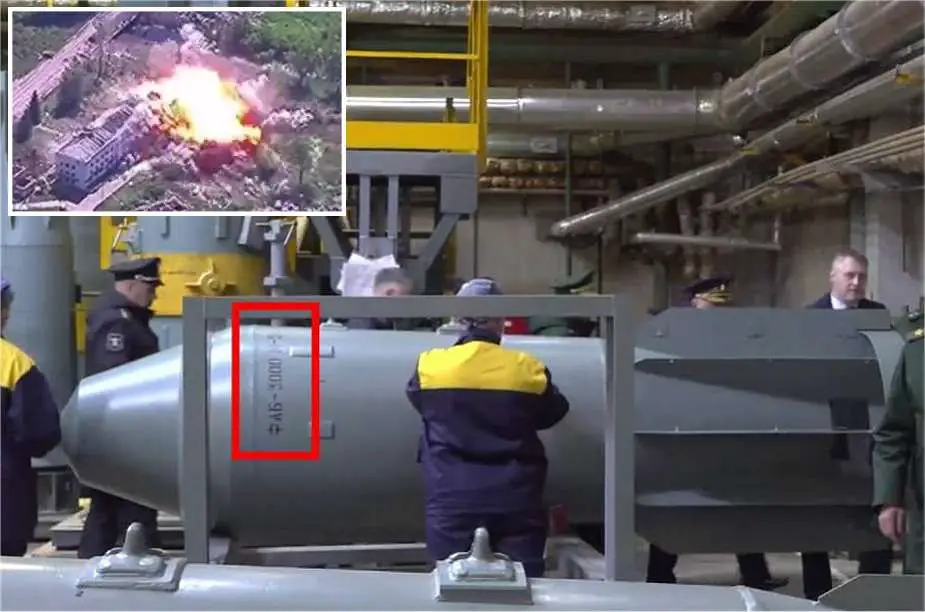Breaking News
Breaking News: Russia Uses Massive FAB-3000 Guided Bomb for the First Time in Ukraine Conflict.
Russia has used the powerful FAB-3000 guided bomb for the first time against Ukrainian positions near Kharkiv. This development was revealed in a video circulating on social media today. The bomb, although missing its intended target, caused serious consequences due to its massive explosive power.
Follow Army Recognition on Google News at this link

The FAB-3000 is a large, Soviet-era, high-explosive aerial bomb weighing 3,000 kilograms, designed for maximum destructive impact on fortified targets. (Picture source Russian MoD)
The FAB-3000, a three-ton high-explosive bomb containing 1.4 tons of Trinitrotoluene (TNT), was recently enhanced with an UMPK guidance kit. This kit not only allows for precision targeting but also extends the bomb's range to up to 80 kilometers when released from an aircraft.
The Russian UMPK (Universal Modular Platform Kit) guidance kit is a system developed to transform unguided bombs into precision-guided munitions. This innovation is part of Russia's strategy to enhance the capabilities of its existing arsenal of aerial bombs by integrating advanced guidance systems. The UMPK kit is designed to be modular, meaning it can be adapted to fit a wide variety of unguided bombs, thus providing a flexible and cost-effective upgrade solution.
The primary advantage of the UMPK guidance kit is its ability to improve the accuracy and effectiveness of bombs significantly. By adding guidance capabilities, the kit ensures that the munitions can hit their intended targets with greater precision, reducing collateral damage and increasing the overall effectiveness of military operations. This system helps to bridge the gap between traditional unguided bombs and more advanced, purpose-built precision-guided munitions, offering a practical upgrade path for existing weapon stockpiles without the need for completely new weapons systems.
The use of such a heavy and destructive weapon marks a notable moment in the conflict, highlighting the intensifying military strategies employed by Russia. The bomb's deployment near Kharkiv, a region that has seen significant military activity, underscores the ongoing volatility and the potential for further escalations in the area.
While the bomb did not hit its precise target, the explosion's impact was still severe, illustrating the destructive capability of the FAB-3000. The incident has raised concerns among international observers about the increasing use of advanced and highly destructive weaponry in the conflict.
The FAB-3000 is a formidable three-ton high-explosive bomb, developed during the Soviet era and remains one of the largest conventional bombs in Russia's military arsenal. Designed to deliver a substantial explosive payload, the FAB-3000 has been recently upgraded with modern guidance systems to enhance its effectiveness in contemporary combat scenarios.
Weighing in at three tons, the bomb carries a payload of 1.4 tons of Trinitrotoluene (TNT), a robust explosive material. This makes the FAB-3000 particularly devastating upon detonation, capable of causing extensive damage to its target and surrounding areas.
The bomb has been significantly enhanced with the addition of the UMPK (Universal Modular Planning Kit). This kit transforms the FAB-3000 from a traditional free-fall bomb into a guided munition. It incorporates advanced GPS and inertial navigation systems, allowing precision targeting. The UMPK kit also extends the bomb's effective range, enabling it to be guided up to 80 kilometers (about 50 miles) from the point of release. This extended range offers tactical advantages, allowing aircraft to deploy the bomb from a safer distance, thus reducing their exposure to enemy anti-aircraft defenses.
The FAB-3000 can be deployed from various Russian aircraft, making it a versatile addition to the country's aerial arsenal. The ability to deliver such a powerful bomb from a considerable distance underscores the advanced military capabilities and strategic flexibility that the FAB-3000 provides to the Russian armed forces. This bomb's deployment in the conflict near Kharkiv highlights the escalating use of advanced weaponry in the ongoing tensions, raising concerns about the increasing intensity and potential devastation of the military engagements in the region.


























